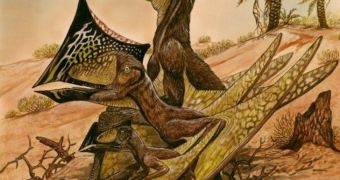Lady Gaga might like to strut around in shocking outfits and pretend like this is something she alone can pull off, but as it turns out, beasts that lived millions of years ago did it first. And judging by the image next to this article, they did it better.
The image shows an artist's reconstruction of three ancient flying reptiles that roamed the Earth during the Cretaceous and that looked as if they had a seriously oversized – yet quite beautifully colored – butterfly glued to their heads.
In a paper published in the journal PLOS ONE this past August 13, researcher Paulo Manzig with the Universidade do Contestado in Brazil and his colleagues explain that these flying reptiles constitute a previously undocumented species.
According to Science Daily, the remains of about 50 such ancient beasts were unearthed in southern Brazil not too long ago. After studying them, Paulo Manzig and fellow researchers found that they were unlike other fossils thus far documented by science.
Hence, the paleontologists concluded that the specimens were representatives of a new species, which they decided to name Caiuajara dobruskii. These creatures are believed to have roamed the Earth about 80 million years ago.
In their paper in the journal PLOS ONE, researchers detail that the fossilized remains were pulled from a pterosaur bone bed. Consequently, the flying reptiles are now argued to constitute a previously undocumented species belonging to this group.
The fossils that the paleontologists found and analyzed were left behind by both very young specimens and adults. The wing spans of these flying reptiles ranged from 0.65 to 2.35 meters (approximately 2.13 to 7.7 feet), information shared with the public says.
Based on the anatomical particularities of these specimens, it was concluded that ancient flying reptiles belonging to this species started their lives sporting a small and inclined crest. As they matured, the crest grew in size and became steep, Paulo Manzig and fellow researchers explain.
“Ontogenetic variation of Caiuajara dobruskii is mainly reflected in the size and inclination of the premaxillary crest, changing from small and inclined (~115°) in juveniles to large and steep (~90°) in adults,” the Universidade do Contestado paleontologists say.
Since the fossilized bones were all recovered from the same location, the Universidade do Contestado researchers believe that the flying reptiles lived in fairly large groups comprising both adults and juveniles. Whether they got along all that well with one another or they simply tolerated each other's presence remains a mystery.
“The available information suggests that this species was gregarious, living in colonies, and most likely precocial, being able to fly at a very young age, which might have been a general trend for at least derived pterosaurs,” the researchers write in the Abstract to their paper.

 14 DAY TRIAL //
14 DAY TRIAL //